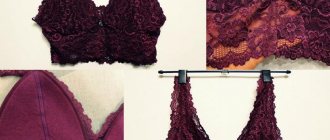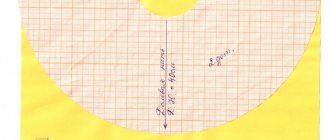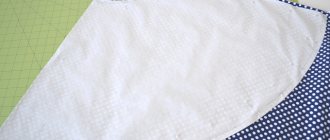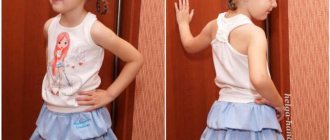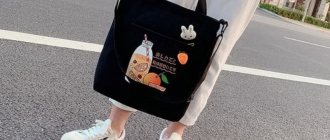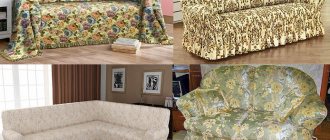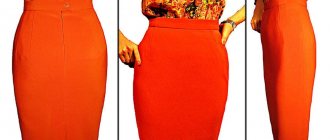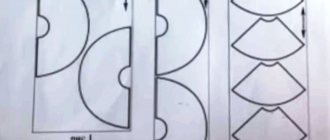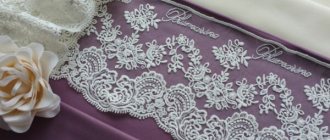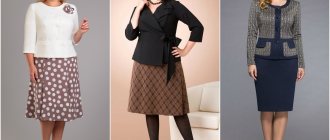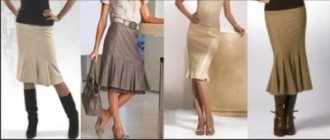Modern fashionistas value versatile clothing items that are suitable for any body type and look feminine and stylish. Many craftswomen prefer to create exclusive things with their own hands. And then the question arises: how to sew a circle skirt quickly, but efficiently. Flared models have been popular at all times, in contrast to tapered and straight products, which are not suitable for everyone. Such skirts add a touch of mischief and girlish exuberance to even the most formal looks.
What it is
Externally, the skirt looks like flared clothing, which is why it is called flared differently. It has a round shape, reminiscent of the sun, which is why it got its name. The product is suitable for girls with any type of figure. The loose cut allows you to hide curvy hips and highlight the advantages of slender legs.
Skirt on a skinny girl
For girls who are too thin, the “sun” will help add the necessary volume to the lower parts of the body. The thin waist will be emphasized, and the image will become more airy and feminine in appearance.
Curvy fashionistas should give preference to skirts made of thin materials. They will hide all the flaws of the figure and highlight the advantages of the owner.
Curvy figure model
Important! It must be taken into account that the style of the skirt tends to affect a person’s height, reducing it. A short girl should not forget to wear high-heeled shoes, and tall beauties should not buy items that are too short.
Who should wear what:
- Miniskirts are mainly suitable for slender girls of short and medium height. On other women, the products look inappropriate and vulgar, highlighting the disadvantages of the figure.
- Midi length is a universal option. The product looks great on both thin and plump girls. The skirt can be worn to festive events, to work or school, and can also be used as an everyday item. It goes with almost any top, you just need to choose the right color scheme.
- Floor-length skirts with a train made of light fabric are necessary for every fashionista in the summer season. They can be combined with sandals, sandals, ballet flats or heels.
Floor-length skirt, pleated
Note! It is worth paying attention to the length of clothing.
How to choose fabric
When choosing fabric, you need to start from the type of figure and length of the product. Both natural and synthetic materials are used to create clothing.
Lightweight fabrics:
- Fatin. Externally, the clothes are similar to a ballerina's wardrobe item. It looks great with T-shirts and thin blouses, and adds freshness and youth to the image. In addition, ballet tutus are now at the peak of popularity.
Fatin
- Chiffon. Skirts made of chiffon fabric look airy and elegant. They usually consist of several layers, as the fabric is too thin and transparent in appearance.
You might be interested in Sewing a fabric organizer for socks and underwear yourself
Chiffon
- Cotton. The natural material looks simple and stylish at the same time. The environmentally friendly and healthy component does not cause allergic reactions on the skin. It retains its shape well and is suitable for wearing in any season. Cotton products are suitable for both children and adult women.
Cotton
- Organza. Thin organza skirts are popular in the warmer months. They usually look bright and colorful, so they are mainly suitable for walking.
Organza
- Silk or satin. Products made from such material always create a luxurious appearance. They are shiny and smooth, which has a pleasant effect on the skin.
Dense materials:
- Wool. In cold weather, a woolen product can warm you up. Skirts look stylish and fashionable on any girl; they go well with tights and any shoes.
- Leather. Genuine leather or its substitute is actively used for sewing sun-shaped skirts. The result is dense, wear-resistant products that are ready to last for a long time.
Important! The leather is odorless.
Seamless circle skirt
A sun-shaped skirt can be done without seams at all. This skirt is made from solid fabric. You can wear it in any way as long as there are no inserts or pockets on it. If it twists on a girl while wearing it, it will not be noticeable due to the lack of seams.
Seamless
To create a pattern, you need to purchase graph paper, a ruler, a compass and a pencil. The graph paper must be folded in half and construction done on it.
Step-by-step instruction:
- An important point is to calculate the radius of the circle. The radius is calculated using the formula from the school geometry course. The waist circumference along with the allowance must be divided by twice the number pi.
- An angle of 90 degrees is constructed on graph paper, the sides of which are equal to the calculated radius. And then, using a ruler or compass, an arc is drawn from the ends of the radius. This arch is the future top of the product, which sits at the waist.
- On the same sides, a distance equal to the length of the product is measured from the top of the angle. It depends on the desires of the person, so it is sewn at your discretion. The ends are also connected with an arc, and the result is a pattern for half of the skirt. It can be attached to the model and, if necessary, any imperfections on the paper can be corrected.
You might be interested in this: Creating a pattern and sewing a wide belt for a dress
Interesting! This pattern is suitable for any type of sun-shaped skirt, be it one with one or two seams, or a double sun.
Skater skirt pattern for girls
The only difference between the pattern of such a skirt for girls and schoolgirls is that it is cut entirely, without side seams. Children's skirts are most often short and fabric consumption is therefore significantly reduced. This allows you to place the entire circumference on one piece of fabric (150cm x 150cm). The maximum length of a sun skirt tailored in one part is limited by only two parameters R and D. If the sum of these parameters (L) does not exceed 70 cm, then even for an adult you can use this cutting pattern.
To create such a pattern, you need to draw two circles with chalk. The radius of the inner circle is calculated by the formula: R=0.32 x Sb, Sb is the half-circumference of the hips. The distance from the edge of the inner circle (minus the seam allowance for the waistband) to the edge of the fabric will be the maximum length of the skirt (minus the hem allowance for the hem). This skirt can only be sewn with an elasticated belt, and to calculate the formula you need to use the measurement of the semi-circumference of the hips. As a rule, large pleats are not provided for such a skirt, since the more pleats, the larger the radius R will be and the smaller the radius L will be.
Video on how to sew a circle skirt for a girl. The skirt is unlined and has a wide elastic waistband.
With two seams
To create a circle skirt with two seams, create a pattern using the previous method. The parameters of the model are measured, two diameters are calculated using the formula and applied to graph paper.
With two seams
When cutting, it is applied to one layer of fabric and two such semicircles are cut out, which are later connected, and a product with two seams is obtained.
Technology of sewing a circle skirt
The technology of sewing a skirt is not very complicated. The easiest way to sew a circle skirt is with an elasticated belt. There is no need to process the zipper in the side seam, process the belt strap, or make a loop. It is enough to overlock the side seams with an overlocker and stitch them with 1.5 cm allowances.
The seams are ironed on one side, and after that the belt is stitched together and folded in half. A wide elastic band (the width of the belt) can be inserted into it in advance. The stitched belt together with the skirt allowance is overlocked with one seam.
How to make a one-piece belt with a wide elastic band for a children's skirt or pants.
It is very convenient to use a wide decorative elastic band instead of a belt. It is adjusted to the upper section of the skirt in a stretched form. But first, divide the top section of the skirt and the elastic waistband into 4 equal sections. Align the skirt and waistband marks together and secure with pins. Sew the waistband, stretching the sections from “mark to mark”. To prevent the connecting seams of the belt from bursting from stretching when dressing, take the measurement SB 2-3cm larger. See How to sew a skirt with elastic.
Processing the bottom of the skirt is possible in several ways. Firstly, the overcast edge of the bottom of the circle skirt can be folded to the wrong side 0.5 - 0.8 cm wide and a finishing stitch of 0.2-0.3 cm can be given. If you don't have a serger, you can use a zigzag stitch instead of an overlock stitch. The edge of the skirt can also be finished with a double hem. However, the rough edge of a double hem is difficult to lay out on the bias, so most often for light fabrics they use a modification of the double hem, the so-called Moscow seam. For information on how to make it and other ways to hem the bottom of a skirt, see the article “How to hem a skirt.”
Double sun
Double sun - a fluffy version of the skirt. It is made from light, loose fabric and looks great on any figure. Among the advantages are elegance, correction of imperfections and the fact that the product is suitable for all representatives of the fair sex, regardless of age.
Skirt – double sun
Double sun is half the waist circumference. The measured waist size is divided by two, and then again by twice the number pi. The pattern method is exactly the same as for a skirt with two seams, only in the end you get not one continuous fabric, but two parts - the front and back components.
Skirt sun. Instructions for printing patterns and sewing sequence
Difficulty level : easy (for beginners)
SUN-FLARED SKIRT
INSTRUCTIONS FOR PRINTING BASIC PATTERNS
AND SEWING SEQUENCE
Description of appearance : women's flared skirt with a zipper in the right side seam or without a fastener with an elastic band along the top edge.
Recommendations for materials : well-draped materials made from natural, silk and wool fibers and threads, as well as their mixtures, plain or with a pattern.
When ordering a pattern you receive 3 pdf files:
- A file with instructions for printing a pattern, containing a control square and the measurements according to which the pattern was constructed;
- File with pattern in A4 format, for printing on a regular printer
- File with a pattern on one large sheet - for printing on a plotter
Pattern sample:
* PRINTING ON A4 FORMAT PRINTER:
When printing patterns in A4 format, open Adobe Reader and check the “Actual size” checkbox (or uncheck “Fit to page size”) in the print settings.
Note the test square (or grid) on the pattern sheet. Its size is exactly 10 by 10 cm. It is needed in order to understand whether the printing scale is set correctly on your printer. Before printing the entire pattern, print out a sheet with a red square and measure it. 10cm sides? This means you can print the remaining sheets of the pattern. If the sides are more or less than 10 cm, you need to adjust the print scale of your printer. Otherwise, the pattern will not print correctly.
After printing all the pattern pages, glue them together in the order shown: the letters (A/B/C+) indicate the column, and the numbers (01/02/03+) indicate the row. The first (top left) pattern sheet will have the number A01.
*PRINTING ON A PLOTTER:
When printing a pattern on a plotter, open the pattern file in Adobe Reader (or Foxit Reader). Click on the "File" menu item, then select "Print". Select the Poster print mode under Page Sizing and Handling. Make sure the Segment Scale field is set to 100%. Check the boxes for Cutting Marks, Shortcuts, and Split Large Pages Only.
The following designations are used on the pattern:
Parts Specification
MAIN MATERIAL
- The front of the skirt.
- Back of the skirt.
- Belt
If you want to make a gather on the waistband of your skirt with an elastic band, enter your data into the generator and add 10-15 cm to the length of the skirt. Next, determine the size of the gather along the waistline, make changes to the upper section of the skirt so that its length allows you to get the required value assemblies.
When cutting, add allowances for the side seams - 1 cm, along the upper cut of the skirt - 1 cm, along the lower cut - 0.8-1.5 cm (depending on the chosen processing option).
The material consumption when laying out parts according to the diagrams indicated below can be determined using the formulas given.
The average material consumption for a skirt 80 cm long is 3.5-4.0 meters for narrow materials and about 2 meters if the width of the material is at least 2 meters.
In addition to the main material for making a skirt you will need :
- about 10 cm of adhesive cushioning material (with a width of 90 cm);
- zipper - 18-20 cm;
- 1 button.
Technological sequence for processing a skirt (skirt with a zipper in the side seam)
- Baste and stitch the front and back of the skirt along the right side edges.
- Overcast the allowance for finishing the fastener on the front and back of the skirt 9 along the left side cut).
- Baste and stitch the front and back of the skirt along the right side edge from the hem line to the control mark that defines the end of the zipper.
- Sweep the cuts.
- Sew zipper tape into the left side seam of the skirt.
- Duplicate the belt with adhesive interlining material.
- Finish the top section of the skirt with a stitched belt (Fig. 1)
- Finish the bottom edge of the skirt with a hem seam with an open edge or a hem seam with a closed edge.
Rice. 2
Skater skirt with elastic
The belt of a skirt plays an important role in the comfort of wearing and the appearance of the product. Often an alternative option is an elastic band. Girls and young girls feel free to purchase such wardrobe items for themselves. Beautiful appearance and convenience make the products popular.
Skater skirt with elastic
The main difference between this skirt is that instead of a belt, an elastic band is inserted into the upper part.
Constructing a circle skirt pattern
Another feature and advantage of such a skirt is that the pattern can be created directly on the fabric, since complex calculations are not required, such as for a straight skirt. The only drawback of the circle skirt is the high consumption of fabric. That is why when cutting you will need a flat surface 150 cm wide and up to 5 meters long, since the fabric will have to be cut in one layer and completely laid out. At home, such a surface can only be the floor, so clear the area of the floor from unnecessary objects and lay the fabric in one layer, wrong side up.
To create a pattern, you will need to take only three measurements: waist circumference, hip circumference and skirt length. Prepare a chalk, measuring tape and tailor's scissors. Now you can start creating a skirt pattern on the fabric.
Please note that the arrow in the drawing indicates the fractional direction of the fabric. First, choose the version of the skirt pattern you need: without gathering at the waistline or with folds (gathering, folds). Decide in advance what kind of belt you want, one-piece or gathered with an elastic band. The calculation of the volume along the waistline, the length of the belt and the technology for processing the belt will depend on this. If the skirt does not have gathers along the waistline, then you will need to insert a zipper in the side seam and make a button or hook closure. For a long skirt with folds (folds), a zipper and fastener are not used, since the belt is usually made with an elastic band. To construct a pattern, or rather the radii of the semicircles of the upper section of the skirt, you need to choose one of the options.
Options for laying out pattern pieces on fabric
You can lay out the pattern pieces on the fabric in a way that is convenient for you. The most rational method is to place the components close to each other. In this case, much less fabric is consumed.
For skirt lengths up to 55 cm, a skirt cut without seams is created. The pattern is laid out in such a way that the diameter of the belt lies at the fold.
Skirts of longer length are cut from semicircles. Patterns are laid out in any convenient way. It is recommended to place parts next to each other in order to save materials.
Uncover
When cutting, the material is folded in half, and a pattern is applied to it. There may be several location options. One of the most common is to apply a pattern with a diameter to the fold line of the fabric, this way less material is consumed.
You may be interested in this Step-by-step guide to sewing your own bonbon blanket
The paper is secured to the fabric with pins or needles, or outlined on the fabric with chalk. It is recommended to leave some fabric for allowances.
Using scissors, the fabric is cut along the contour, and the result is something similar to a skirt. At this stage, the pattern should be tried on the model before you start sewing.
Cutting out a belt
The belt pattern should be made on graph paper. To do this, cut out a rectangle. Its length is equal to the length of the waist and a couple of centimeters for the seams. The width can be chosen according to the girl’s taste, but when creating a pattern it is doubled.
Cutting out a belt
LiveInternetLiveInternet
https://korfiati.ru/2016/06/vyikroyka-yubki-dvoynoe...%84%D0%B8%D0%B0%D1%82%D0%B8%29
Due to the flared silhouette, the circle skirt makes any waist perfectly thin and your figure incredibly feminine! However, the modern transformation of the circle skirt offers us not only the classic silhouette, but also all kinds of variations. Technological fabrics that have burst into fashion, for example, such as neoprene, are capable of creating incredibly beautiful wave-like shapes at the hem of a skirt, multi-layering - lush volume, and asymmetry along the lower edge - whimsical and at the same time unique designer silhouettes. This skirt has 3 seams - two on the sides and one in the center of the back panel. There is a hidden zipper sewn into the middle seam along the back. Since the skirt is made of neoprene, the sections do not need to be processed.
To create a skirt pattern, you need to take 2 measurements:
Waist circumference (FROM) 72 cm
Skirt length from waist 55 cm
You can increase or decrease the length of the skirt as you wish.
To calculate the first radius R1, we use the formula: R1 = (From/6, 28) /2=72 /6.8 /2=5.75 cm.
R2 = R1+ 55 cm (skirt length according to measurements) = 5.75 + 55 = 60.75 cm.
How to draw a circle with a large diameter?
We will need: a flexible measuring tape, a simple pencil and paper. On the paper, determine the center of the future circle A. Fold the paper in half along the intended point. Use a measuring tape and measure the radius of the future circle on it. Fix the zero point in the center of the circle and fix it with your left hand (it is better to place a measuring tape on the edge). With your right hand, press the measuring tape to the pencil at the required distance (the distance is equal to the radius of the circle). Draw a semicircle R1. Similarly, from the center point, draw the second semicircle R2.
Cut the pattern with scissors and unfold it. Mark the side lines along which you will cut the front part of the skirt.
How to cut a double sun skirt
To sew such a skirt you will need: about 2.30 m of green neoprene 150 cm wide, a hidden zipper 20 cm long, matching threads.
Recommendations for choosing fabric: skirt fabrics that hold their shape well - neoprene, jacquard, cupra, crepe.
Lay out the skirt parts on the fabric folded in half along the grain, pay attention to the layout of the front panel of the skirt - you should step back from the fold of the fabric about 0.7 cm, so that after cutting the panel on one side (side seams), there will be seam allowances.
From the main fabric, cut out:
Front half of the skirt – 1 piece with fold
Back half of the skirt – 2 parts
Belt – 1 piece 9 cm wide (3.5 cm in finished form) and a length equal to the waist circumference + 3 cm for the fastener + 1 cm for freedom of fit + 3 cm for the seams.
All seam allowances are 1 cm, along the bottom of the skirt - 1.5 cm.
How to sew a skirt
Sew the side seams on the skirt and press the allowances. Sew a hidden zipper along the back.
Sew a belt along the waist, and sew a hook onto the belt. Fold and stitch the allowances along the bottom of the skirt.
Sewing
It is recommended to start sewing the product from the belt.
Sew on the belt
The cut rectangle with allowances on all sides is folded and secured with an iron. The seams are fixed with needles or pins. The belt is folded along its length and stitched with a regular line on a typewriter. After processing, the belt is simply sewn to the top seam. Thus, the top of the product is ready.
The skirt needs to be folded at the bottom and ironed with an iron. Then you can overlock the bottom and continue working with the belt.
Belt processing
The top of the skirt is folded 1.5–2 centimeters to create a seam. For convenience, you can iron it or secure it with pins or needles. Then the material is sewn on a machine using a regular stitch. .
How to sew a zipper into a skirt
When sewing a seam on the top of the product, it is necessary to leave a slit for the zipper. Its edges are folded, ironed, a zipper with a slider is inserted and stitched on a sewing machine.
Sewing in a zipper
How to shorten the bottom
If there is a need to shorten the bottom of the skirt, then there is a way out. The finished product must be put on and bent to the desired length. The result of the basting can be secured with needles or chalk. The easiest way is to cut off the excess part with scissors. If you want to get rid of 10 cm, then you should cut off 8, and fold the rest and stitch it on a machine. Thus, you will get a product of the desired length, which will suit your figure and emphasize all its advantages.
Pattern
Calculation and preparation of material
The first thing you have to think about when deciding to sew a circle skirt with your own hands is what fabric is best suited for the product and how much of it will be needed. The material must be smooth and fairly dense to hold its shape. Satin, silk, organza, velor, taffeta, today's fashionable materials - jeans, cotton, linen, jacquard, fine corduroy, light viscose - are perfect.
To sew a summer model, you can choose another option - thin, airy fabric. You can sew a circle skirt from chiffon.
To calculate fabric consumption, you need to make 2 measurements:
- waist circumference;
- length of the product.
The length of the fabric with a width of 1.5 m is calculated as follows: two skirt lengths + 0.5 waist circumference + 10 cm (for fabric shrinkage).
For example, with a desired length of 70 cm and a waist circumference of 60 cm, you will need a cut of 180 cm:
